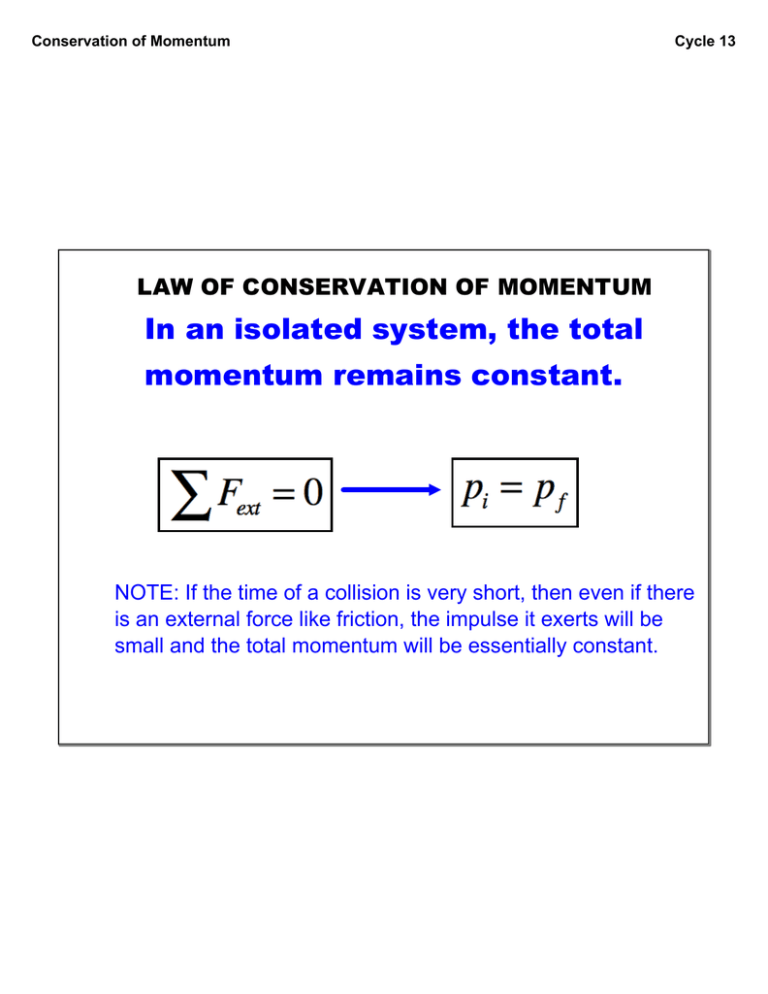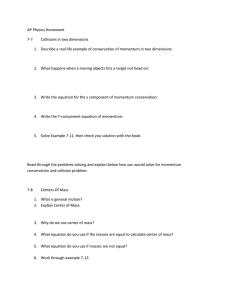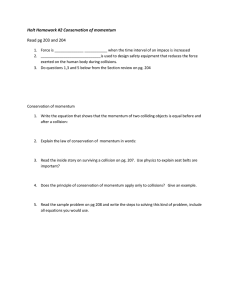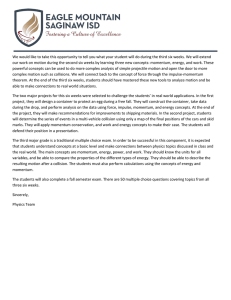In an isolated system, the total momentum remains constant.
advertisement

Conservation of Momentum
Cycle 13
LAW OF CONSERVATION OF MOMENTUM
In an isolated system, the total
momentum remains constant.
NOTE: If the time of a collision is very short, then even if there
is an external force like friction, the impulse it exerts will be
small and the total momentum will be essentially constant.
Conservation of Momentum
-F
Cycle 13
Why Momentum is Conserved
F
In a collision, Forces are
equal and opposite (3rd Law)
clunk!
-Ft = Ft
-Δp = Δp
Times of contact are the same, so the
impulses are also equal and opposite.
Since impulse is equal to the change in
momentum, the changes in momentum
are also equal and opposite.
That means that the momentum one object gains is the same
as the momentum the other object loses.
Therefore the total momentum is constant.
Conservation of Momentum
Cycle 13
Total Momentum
AFTER
BEFORE
Conservation of Momentum
Cycle 13
20 m/s
5 m/s
1000 kg
5000 kg
2 m/s
v=?
Find the velocity of the
truck afterward.
Conservation of Momentum
Cycle 13
TYPES OF COLLISIONS
inelastic
totally
elastic
inelastic
Kinetic E conserved
objects stick
"the perfect bounce"
"complete splat"
Conservation of Momentum
Cycle 13
Completely Inelastic Collisions
20 m/s
5 m/s
1000 kg
5000 kg
BEFORE
v=?
AFTER
{20,000,5,-4} {100,5,905}
Conservation of Momentum
Cycle 13
The Other Side of the Coin
AFTER
BEFORE
{100, 0, -0.2} {0.1, 0, 200}
Conservation of Momentum
V=0
Vi
4M
Cycle 13
BEFORE
M
Vf
AFTER
Find the fraction of Kinetic Energy lost in the totally
inelastic collision
Conservation of Momentum
Cycle 13
Elastic Collisions
Both Momentum and Kinetic Energy
are conserved.
(algebra = yikes!)
Conservation of Momentum
Cycle 13
Huygen's Relation for Elastic Collisions
Object 1's before and after velocities
added together equal object 2's
before and after velocities added
together.
Conservation of Momentum
Cycle 13
Elastic Collisions
My advice: use Huygen's Relation
and Conservation of Momentum.
(Easier algebra!)
Conservation of Momentum
Cycle 13
Linear elastic collision - different masses
3 m/s
2 m/s
BEFORE
0.5
0.5kg
kg
1 kg
v=?
1.33 m/s
AFTER
Conservation of Momentum
Cycle 13
Elastic Collisions
BEFORE
10 m/s
2 kg
4 m/s
4 kg
AFTER
? m/s
? m/s
Conservation of Momentum
Linear elastic collision - same mass
Cycle 13
Conservation of Momentum
5 m/s
Cycle 13
0 m/s
0.5 N/cm
300 g
200 g
Assuming the surface has negligible friction, find the maximum
compression of the spring.
Conservation of Momentum
5 m/s
2 kg
0 m/s
3 kg
Cycle 13
The blocks collide
and stick. Find the
maxiumum height to
which they rise
afterward. (Assume
the surface has
negligible friction.)
Conservation of Momentum
Non-linear collisions
Cycle 13
Conservation of Momentum
Cycle 13
Non-linear elastic collision - same mass
Conservation of Momentum
Cycle 13
Elastic 2D Collision
vi = 0
vi = 5 m/s
2 kg
2 kg
2 kg
vf = ?
30o
θ=?
vf =2.5 m/s
2 kg
Conservation of Momentum
Cycle 13






